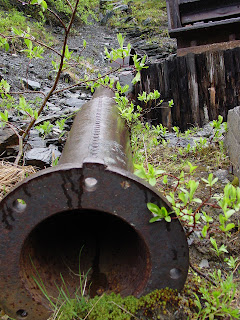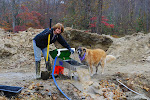On a day that seemed too cool, cloudy, and rainy to go mining ourselves, we drove up the mountains to the headwaters of Palmer Creek with Judy and Gary in their 4WD pickup truck. It's the site of several old "Lode" mines that haven't been operated for some time now. For those who don't already know, there are two basic types of gold mining: lode and placer. Lode refers to gold still in the mountain, in the rock, in the hole, and is sought by the classic mining operation that digs the hole or the shaft, hauls out the rock with the ore, separates it by whatever means will work usually involving crushing it, then recovers it from the crushed rock. It is the style of mining you see in the old movies where the bearded miner puts on his hat, rides into the mine on an ore cart carrying a pick-ax and a shovel. Of the two methods of mining it is, I should think, by far and away the more dangerous. Placer gold has already been separated from its host mineral through the process of erosion. It can be found in any dirt or gravel where it is present by sluicing and panning and other more powerful but basically similar processes. The classic image of the old timer panning by the side of the stream while his jackass munches some grass along the banks is placer mining in its purest form.


Above and below, mountain streams flow freely from the mountains. The lode mines, high on the hillside and now mostly overgrown by brush are largely unaccessible without a major physical effort to climb up the hill. But the mines were played out some time back, and many of the old mines have become unsafe to enter- so we didn't give that a try. It was just a beautiful thing to be present in the valley of the lodes and to try and feel the spirit of all the activity that had gone on in years prior. Small Graylings frolicked in the rushing waters, and until you have stood in that valley and heard the waters rushing down each and every hillside from each and every direction, "surround sound" is something you just can't possibly understand.

I had an art gallery in Maine 10 or so years ago. I personally liked and appreciated much of the art we showed and sold. But we also included in our offerings some rather strange pieces that were largely assembled junk, called art, and put up for sale. The fact that some folks bought them never did make them art in my eyes, but then beauty, as they say, is in the eye of the beholder. To be sure, it is a fine line at times between junk and art. I think it must be the history that makes the difference. So standing and looking at the old remains of the lode mining (or any mining operation for that matter) speaks to me of art in a way. There was all this man made stuff, heavy and massive and not particularly beautiful in its design- more mechanical by nature, that, through the years and the influence of nature and history and time itself, has somehow assimilated itself into the landscape and become a part of it in a degree that could never have been predicted when the operation was begun. So as I looked at old fly wheels, water drive wheels, hand rolled and riveted steel pipe, belt drive shafts and rock crushing hoppers- I saw the art that was left behind by the process and not the junk that was originally abandoned and left to weather.



Souvenir hunters have hauled off a lot of what was light enough to manage, leaving only the massive iron parts to tell the story of the miners and their operation, but it was a story well told on the mountainside on this otherwise dismal day. The music of the streams played in the back ground and the stars of the story were once again alive in the hearts and minds of those of us there to pay our respects.


 Above and below, mountain streams flow freely from the mountains. The lode mines, high on the hillside and now mostly overgrown by brush are largely unaccessible without a major physical effort to climb up the hill. But the mines were played out some time back, and many of the old mines have become unsafe to enter- so we didn't give that a try. It was just a beautiful thing to be present in the valley of the lodes and to try and feel the spirit of all the activity that had gone on in years prior. Small Graylings frolicked in the rushing waters, and until you have stood in that valley and heard the waters rushing down each and every hillside from each and every direction, "surround sound" is something you just can't possibly understand.
Above and below, mountain streams flow freely from the mountains. The lode mines, high on the hillside and now mostly overgrown by brush are largely unaccessible without a major physical effort to climb up the hill. But the mines were played out some time back, and many of the old mines have become unsafe to enter- so we didn't give that a try. It was just a beautiful thing to be present in the valley of the lodes and to try and feel the spirit of all the activity that had gone on in years prior. Small Graylings frolicked in the rushing waters, and until you have stood in that valley and heard the waters rushing down each and every hillside from each and every direction, "surround sound" is something you just can't possibly understand. I had an art gallery in Maine 10 or so years ago. I personally liked and appreciated much of the art we showed and sold. But we also included in our offerings some rather strange pieces that were largely assembled junk, called art, and put up for sale. The fact that some folks bought them never did make them art in my eyes, but then beauty, as they say, is in the eye of the beholder. To be sure, it is a fine line at times between junk and art. I think it must be the history that makes the difference. So standing and looking at the old remains of the lode mining (or any mining operation for that matter) speaks to me of art in a way. There was all this man made stuff, heavy and massive and not particularly beautiful in its design- more mechanical by nature, that, through the years and the influence of nature and history and time itself, has somehow assimilated itself into the landscape and become a part of it in a degree that could never have been predicted when the operation was begun. So as I looked at old fly wheels, water drive wheels, hand rolled and riveted steel pipe, belt drive shafts and rock crushing hoppers- I saw the art that was left behind by the process and not the junk that was originally abandoned and left to weather.
I had an art gallery in Maine 10 or so years ago. I personally liked and appreciated much of the art we showed and sold. But we also included in our offerings some rather strange pieces that were largely assembled junk, called art, and put up for sale. The fact that some folks bought them never did make them art in my eyes, but then beauty, as they say, is in the eye of the beholder. To be sure, it is a fine line at times between junk and art. I think it must be the history that makes the difference. So standing and looking at the old remains of the lode mining (or any mining operation for that matter) speaks to me of art in a way. There was all this man made stuff, heavy and massive and not particularly beautiful in its design- more mechanical by nature, that, through the years and the influence of nature and history and time itself, has somehow assimilated itself into the landscape and become a part of it in a degree that could never have been predicted when the operation was begun. So as I looked at old fly wheels, water drive wheels, hand rolled and riveted steel pipe, belt drive shafts and rock crushing hoppers- I saw the art that was left behind by the process and not the junk that was originally abandoned and left to weather.

 Souvenir hunters have hauled off a lot of what was light enough to manage, leaving only the massive iron parts to tell the story of the miners and their operation, but it was a story well told on the mountainside on this otherwise dismal day. The music of the streams played in the back ground and the stars of the story were once again alive in the hearts and minds of those of us there to pay our respects.
Souvenir hunters have hauled off a lot of what was light enough to manage, leaving only the massive iron parts to tell the story of the miners and their operation, but it was a story well told on the mountainside on this otherwise dismal day. The music of the streams played in the back ground and the stars of the story were once again alive in the hearts and minds of those of us there to pay our respects.









No comments:
Post a Comment